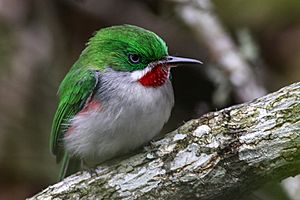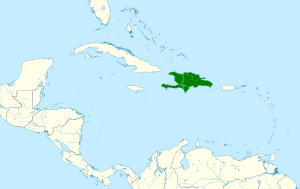Narrow-billed tody facts for kids
Quick facts for kids Narrow-billed tody |
|
|---|---|
 |
|
| Conservation status | |
| Scientific classification | |
| Genus: |
Todus
|
| Species: |
angustirostris
|
 |
|
The narrow-billed tody (Todus angustirostris) is a very small, bright green bird. It is found only on the island of Hispaniola in the Caribbean. This island is shared by the Dominican Republic and Haiti. It is one of five types of birds called "todies" that live in this region.
Contents
About the Narrow-Billed Tody
The narrow-billed tody is a unique bird found only on Hispaniola. Scientists once thought it was closely related to another tody on the same island. However, studies show that the narrow-billed tody actually came from the Cuban tody. Its relatives arrived on Hispaniola millions of years ago.
What It Looks Like
All todies are very small birds with a chunky body and a short tail. The narrow-billed tody weighs about 7.5 grams (0.26 ounces). That's about the weight of two pennies!
Its back and wings are bright green, almost like an emerald near its white eyes. It has a bright red chin and throat. The sides of its neck and chest are gray, while its belly is white. Its sides are a pretty pink or red color. The underside of its wings is yellow. Its top beak is black, and its bottom beak is red with dark tips.
Where It Lives
The narrow-billed tody lives all over Hispaniola, in both the Dominican Republic and Haiti. It mostly prefers thick, wet forests and jungles. You can usually find it in mountains, between 900 and 2,400 meters (2,950 and 7,870 feet) high. Sometimes, it can be seen in lower areas too. In these lower places, it might live near the broad-billed tody, another bird from Hispaniola.
How It Behaves
What It Eats
The narrow-billed tody mostly eats insects. Scientists have found at least 49 different kinds of insects in their diet! Interestingly, they do not eat large butterflies or caterpillars. These are often eaten by the broad-billed tody.
The narrow-billed tody often looks for food high up in the trees. It sometimes joins groups of different bird species looking for food together. They also feed lower down, among coffee plants in farms.
Reproduction and Life Cycle
When narrow-billed todies want to find a mate, they perform special flights. They do this without making any sounds, which is similar to other birds in their group. But they also make a unique wing rattling sound during these flights.
Both the male and female birds dig a nest. They make a burrow about 30 centimeters (12 inches) deep in an earthen bank. A female usually lays one to four shiny white eggs. They typically lay one set of eggs each year, between April and July. Both parents help to keep the eggs warm. After the young birds leave the nest, the parents separate. They might not mate with each other again the next year.
What It Sounds Like
A common sound from the narrow-billed tody is a two-note call. It sounds like "chip-chee," with the second part being louder. They also make a short chattering sound.
Conservation Status
The narrow-billed tody is currently listed as a species of "Least Concern." This means it is not in immediate danger of disappearing. However, its numbers are thought to be going down. This is mainly because its forest home is being lost.
See also
 In Spanish: Barrancolí picofino para niños
In Spanish: Barrancolí picofino para niños


